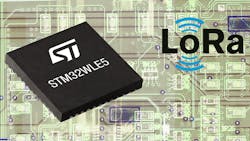SoC Forms Foundation of Smart Devices with LoRa IoT Connections
The STM32WLE5 SoC is touted by developer STMicroelectronics as the first LoRa system-on-chip (SoC) for connecting smart devices to the Internet of Things (IoT) using long-distance wireless connections. As a result, it opens the door for product developers to create devices such as remote environmental sensors, meters, trackers, and process controllers that help efficiently manage energy and resources.
The SoC combines ST’s ultra-low-power STM32 microcontroller design with a LoRa-compliant radio in one single-die and easy-to-use device. ST’s LoRaWAN software for wireless network communications has passed all regional certifications for use worldwide.
Available in a 5- × 5-mm UFBGA73 package, the STM32WLE5 is fully integrated into the STM32 ecosystem, including STM32Cube software support, as well as a LoRaWAN stack certified for all regions and available in source-code format.
The integrated radio, based on Semtech SX126x IP, is engineered with dual high- and low-power transmitter modes that cover the entire global sub-1-GHz unlicensed frequency range from 150 to 960 MHz, ensuring compatibility with LoRa networks in all territories. Hence, OEMs can use STM32WLE5 in all world markets, ensuring technical compatibility, and aiding operational efficiency and customer support. Sensitivity down to −148 dBm, and two embedded power amplifiers with up to 15 dBm and up to 22 dBm maximum transmit power available in the same package, maximize RF range.
In addition to the embedded LoRa modulation, the STM32WLE5 is also capable of (G)FSK, (G)MSK, and BPSK modulation, thus allowing for various alternative protocols including proprietary protocols. Moreover, high RF performance with low power consumption ensures reliable wireless connectivity and extends the runtime of battery-powered devices.
The microcontroller leverages ST’s STM32L4 architecture, which features the Arm Cortex-M4 core with DSP extensions. It also delivers ultra-low-power technologies including dynamic voltage scaling and ST’s adaptive real-time ART Accelerator for zero-wait execution from flash.
Generous 64-, 128-, and 256-kB flash options let developers choose the optimal code and data-storage density for the entire platform, including application and radio.
Users also benefit from the built-in cybersecurity features of STM32L4 microcontrollers, including hardware public key accelerator (PKA), true random-number generator (TRNG), sector protection against read/write operation (PCROP), and support for state-of-the-art cryptographic algorithms such as RSA.
STMicroelectronics, www.st.com/stm32wl
About the Author
David Maliniak
Executive Editor, Microwaves & RF
I am Executive Editor of Microwaves & RF, an all-digital publication that broadly covers all aspects of wireless communications. More particularly, we're keeping a close eye on technologies in the consumer-oriented 5G, 6G, IoT, M2M, and V2X markets, in which much of the wireless market's growth will occur in this decade and beyond. I work with a great team of editors to provide engineers, developers, and technical managers with interesting and useful articles and videos on a regular basis. Check out our free newsletters to see the latest content.
You can send press releases for new products for possible coverage on the website. I am also interested in receiving contributed articles for publishing on our website. Use our contributor's packet, in which you'll find an article template and lots more useful information on how to properly prepare content for us, and send to me along with a signed release form.
About me:
In his long career in the B2B electronics-industry media, David Maliniak has held editorial roles as both generalist and specialist. As Components Editor and, later, as Editor in Chief of EE Product News, David gained breadth of experience in covering the industry at large. In serving as EDA/Test and Measurement Technology Editor at Electronic Design, he developed deep insight into those complex areas of technology. Most recently, David worked in technical marketing communications at Teledyne LeCroy, leaving to rejoin the EOEM B2B publishing world in January 2020. David earned a B.A. in journalism at New York University.

